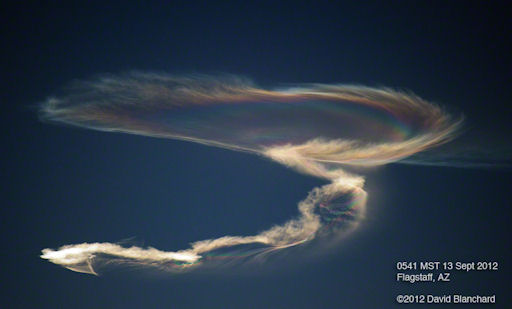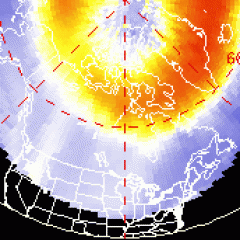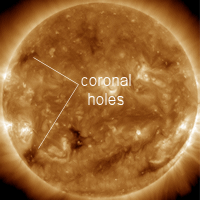~Space Weather Update~ ASTEROID FLYBY: [1]
ASTEROID FLYBY: Today, an asteroid as wide as three football fields is flying past Earth. At closest approach, 2012 QG42 will be 2.8 million km (7.4 lunar distances) away, so there is no danger of a collision. Nevertheless, it is close enough for backyard astronomers to track using large amateur telescopes; the space rock is glowing like a 14th magnitude star. [movie [2]] [3D orbit [3]] [ephemeris [4]]
ROCKET EXHAUST: The White Sands Missile Range in New Mexico conducted a test of the Patriot interceptor yesterday, producing iridescent rocket exhaust visible as far away as Phoenix AZ, Las Vegas NV, and Salt Lake City UT. David Blanchard photographed the display from Flagstaff, Arizona:
The test proceeded as follows: A Juno rocket was launched from Fort Wingate in Gallup, New Mexico. This served as the target for another missile, the Patriot Advanced Capability 3 interceptor, launched shortly thereafter from White Sands. A press release from White Sands confirmed the test and stated that "the
Juno performed as expected."
In a wide-angle view [6], Blanchard captured the exhaust from both missiles. "The crescent Moon overhead was a beautiful bonus," he says.
As the rockets raced through the high atmosphere, water vapor in their exhaust crystalized to form tiny ice crystals. The crystals diffracted the light from the rising sun to produce the iridescent colors. More images: #1 [7], #2 [8], #3 [9], #4 [10], #5 [11], #6 [12], #7 [13],

![]()
Solar wind
speed: 449.5 km/sec
density: 1.7 protons/cm3
explanation [14] | more data [15]
Updated: Today at 1456 UT
![]()
X-ray Solar Flares
6-hr max: B3 1323 UT Sep14
24-hr: B3 1323 UT Sep14
explanation [16] | more data [17]
Updated: Today at: 1459 UT
![]()
![]()
![]()
Daily Sun: 13 Sep 12
![]()
![]()
Departing sunspot 1564 poses a slight threat for M-class [19] solar flares, not Earth-directed. Credit: SDO/HMI
![]()
![]()
![]()
Sunspot number: 44
What is the sunspot number? [20]
Updated 12 Sep 2012
Spotless Days
Current Stretch: 0 days
2012 total: 0 days (0%)
2011 total: 2 days (<1%)
2010 total: 51 days (14%)
2009 total: 260 days (71%)
Since 2004: 821 days
Typical Solar Min: 486 days
Update 12 Sep 2012
The Radio Sun
10.7 cm flux: 105 sfu
explanation [21] | more data [22]
Updated 12 Sep 2012
![]()
![]()
![]()
Current Auroral Oval:
![]()
Switch to: Europe, USA, New Zealand, Antarctica
Credit: NOAA/POES
![]()
![]()
![]()
Planetary K-index
Now: Kp= 2 quiet
24-hr max: Kp= 2 quiet
explanation [24] | more data [25]
![]()
Interplanetary Mag. Field
Btotal: 5.0 nT
Bz: 4.2 nT north
explanation [26] | more data [27]
Updated: Today at 1456 UT
![]()
![]()
![]()
Coronal Holes: 12 Sep 12
![]()
![]()
A pair of coronal holes is emerging over the sun's eastern limb. Credit: SDO/AIA.



